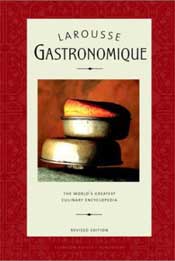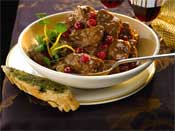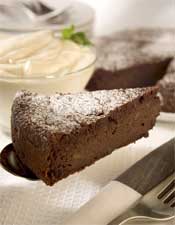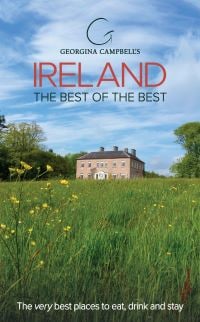CHRISTMAS COUNTDOWN - Beef Casserole with Cranberries and Port / Chestnut and chocolate cake / Chestnuts
 The Christmas countdown is well and truly ticking now, so a few gift suggestions and dishes to cook ahead for entertaining over the holiday period may be welcome.
The Christmas countdown is well and truly ticking now, so a few gift suggestions and dishes to cook ahead for entertaining over the holiday period may be welcome.
A comprehensive cookery book is always a good present for someone starting off in their first home and, if you think a classic would be welcome, Larousse Gastronomique has recently been issued in four paperback volumes (Fish & Shellfish; Vegetables & Salads; Desserts Cakes & Pastries – each UK£9.99; and Meat, Poultry & Game, UK£12.99); individually or as a set they would make a great start for a cookery reference collection.
On a lighter, more everyday, level Jamie Oliver fans will welcome Cook With Jamie – My Guide to Making You a Better Cook (Penguin hardback, 448pp, UK£26); with information on the best equipment for your kitchen and advice on how to be a better shopper as well as loads of recipes, this accessible big book is bound to please.
And, with baking coming into fashion as the new knitting, many cooks of all ages and levels of experience will find hours of blissful relaxation through Leiths Baking Bible by Susan Spaull & Fiona Burrell (Bloomsbury hardback 672pp UK£35); as with all the cookbooks in the Leiths series there is an emphasis on technique, which is very confidence-inspiring.
For those of us with a love of the Sunday roast and a respect for down-to-earth good food with real flavour, Jennifer McLagan’s Cooking On The Bone - Recipes, History & Lore (Grub Street hardback 272 pp UK£20) demonstrates that there is food beyond the boneless supermarket world of chicken breasts and fillets of everything; this is a book for someone – perhaps the man in your kitchen - who will enjoy seeking out the local butcher and learning (or re-learning) the delicious difference that it can make to cook meat, poultry, game and fish with the bones in.
Francophiles, on the other hand, will love Sarah Woodward’s The Food of France: A Regional Celebration (Kyle Cathie hardback 208pp UK£25); this attractive book includes lots of scenic photographs to set the delicious dishes in context – a visual treat and a very covetable book. On the other hand Leaves From Our Tuscan Kitchen by Janet Ross and Michael Waterfield (Grub Street hardback 176 UK£12.99) predates the glossy productions that we now expect, as it was first published in 1899: content is the main point of interest in this pioneering cookery book which chronicles the creative cooking of Giuseppe Volti, Janet Ross’s cook for over thirty years, with revisions and updates by her nephew Michael Waterfield, who lives in Dorset and was previously a restaurateur – a fascinating gift for the gardener and/or food historian in your life.
Beef Casserole with Cranberries and Port
 With all the turkey and ham around over Christmas, a beef party casserole will be as welcome as the flowers of spring - you can prepare this dish ahead and freeze it, ready for an informal get together at any time. Serves 10
With all the turkey and ham around over Christmas, a beef party casserole will be as welcome as the flowers of spring - you can prepare this dish ahead and freeze it, ready for an informal get together at any time. Serves 10
2 tablesp. flour
2 teasp. ground mace
Salt and pepper
3 kg/61/2 lb diced lean beef, well trimmed
3 tablesp. oil
3 large onions, chopped
4-5 cloves garlic, chopped
4-5 sticks of celery chopped
1 tablesp. whole grain mustard
Glass of red wine
Glass of port
600ml/ 1 pint beef stock
2-3 bay leaves
2 tablesp. fresh oregano or thyme, chopped
300g/11 oz (approx) cranberries
To garnish: sprigs of watercress and strips of orange peel
Mix the flour, mace and seasoning together. Toss the diced beef in the seasoned flour. Heat the oil in a large pan and brown the beef, in batches, then transfer to a large flameproof casserole dish. Add the onions, garlic and celery to the pan and saute for 3-4 minutes, then add mustard and wine. Bring to the boil and reduce for a few minutes. Pour the lot over meat in the casserole. Add the port, stock, herbs and half of the cranberries.
Cover and cook gently for about 2 hours, until the meat is tender, or cook in a moderate oven, 180°C, 375°F, Gas Mark 4, for about the same time. 15 minutes before the end of cooking time, add in the remaining cranberries. Check the seasoning before serving and garnish with sprigs of watercress and orange. Lovely served with creamy mashed potatoes and crusty bread toasted, and drizzled with olive oil and chopped herbs.
SHORT RECIPE: Chestnut and chocolate cake
 This rich, moist cake makes a delicious alternative to Christmas pudding and/or the cake for those who dislike dried fruit mixtures, or to round off a dinner party at any time through the winter, and it could be frozen if required. The refreshing sharpness of chilled crème fraîche is the perfect accompaniment for any dessert containing chestnuts, or you could try maple syrup cream (whipped cream flavoured with maple syrup).
This rich, moist cake makes a delicious alternative to Christmas pudding and/or the cake for those who dislike dried fruit mixtures, or to round off a dinner party at any time through the winter, and it could be frozen if required. The refreshing sharpness of chilled crème fraîche is the perfect accompaniment for any dessert containing chestnuts, or you could try maple syrup cream (whipped cream flavoured with maple syrup).
435g/15 oz tin chestnut puree (available Epicure
125g/5 oz unsalted butter
1 tsp vanilla essence
1 tbsp dark rum
6 large eggs separated
250g/9 oz melted chocolate
Pinch of salt
50g/ 2 oz caster sugar
25g/ 1 oz light muscovado sugar
Preheat the oven to 180’C/gas mark 4. Greased and line a 22cm/8 in spring form tin
Using a hand held mixer beat the chestnut puree with the butter then add the vanilla, rum, egg yolks and melted chocolate together.
In another bowl whip the egg whites and the salt until foamy. Add the caster sugar gradually to form stiffer glossy peaks, and then fold in the muscovado sugar. Fold the egg white mixture into the chestnut mixture gently, one third at a time.
Pour the mixture into the tin and cook for 45 minutes. When baked the cake will have a dry cracked texture. Cool in tin for 20 minutes and then turn out onto a rack. Dust with icing sugar to serve.
INGREDIENT OF THE WEEK: CHESTNUTS
 What Are They?
What Are They?
Nuts of the sweet chestnut Castanea Fagaceae, a hardy deciduous tree with ribbed bark, toothed leaves and flowers in catkins. Like its familiar inedible cousin, the horse chestnut, the large red-brown nuts about 1 in/2.5 cm wide are borne in spiny burs; sweet chestnuts are darker than horse chestnuts (‘conkers’), and less rounded, with one flat side.
Where Do They Come From?
The edible chestnuts we associate with Christmas are the nuts of the or Spanish tree, Castanea sativa, a handsome tree which is native to Southern Europe, Asia Minor and North Africa and, although not very common here, it is also grown in parks and gardens in Britain and Ireland.
Where Can I Get Them?
At this time of year chestnuts – and usually only for a short season - are easily available from greengrocers, specialist food shops and supermarkets.
What Can I Do With Them?
These delicious subtly-flavoured nuts can be roasted in the oven, or in a pan / over a fire in traditional manner (slit a circular incision through the husk and inner skin with a sharp knife before roasting to prevent them exploding and make them easier to peel); although not a common sight in Ireland they are still cooked in the streets over braziers in most European cities. Here they are more likely to be used as an ingredient in, for example, chestnut stuffing to serve with goose – a recipe is given in Larousse Gastronomique - Vegetables & Salads (see books as gifts, above) along with others for boiled chestnuts, braised chestnuts, chestnut pur?e (also available tinned, eg Epicure brand), chestnut soup, stewed chestnuts and several less known dishes such as omelette à la chatelaine (omelette filled with a savoury chestnut mixture).






There are currently no comments
Leave a comment
Not a member? Register for your free membership now!
Or leave a comment by logging in with: